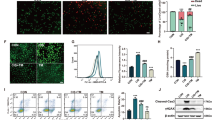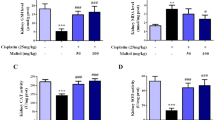Abstract
Cisplatin, a first-line chemotherapeutic agent commonly used to treat various solid tumors, induce severe adverse effects, especially nephrotoxicity, which largely limits its clinical application. However, the currently used measures to prevent nephrotoxicity are not ideal owing to the mechanisms underlying cisplatin-induced nephrotoxicity are not comprehensively understood. Herein, we examined the effects of silibinin on cisplatin-induced nephrotoxicity and found that silibinin exerted cytoprotection effects during cisplatin treatment in HEK293 cells and in a cisplatin-induced acute kidney injury (AKI) model. Mechanistically, silibinin ameliorated cisplatin-induced AKI via decreasing ROS-mediated MAPK signaling pathway activation, which was confirmed using the inhibitor N-acetylcysteine. Moreover, the protective effect of silibinin against cisplatin-induced ROS generation through the antioxidant transcription factor nuclear factor-erythroid 2-related factor 1 (Nfe2l1), rather than Nfe2l2, mediates HO1 expression. Furthermore, interference with the abundance of Nfe2l1 using siRNA or an overexpression plasmid enhanced or decreased the effect of cisplatin-induced apoptosis, respectively, in HEK293 cells. Interestingly, Nfe2l1 protein stability was more sensitive to cisplatin than that of Nfe2l2. More importantly, the mechanism that silibinin activates Nfe2l1-mediated antioxidant responses was confirmed in a cisplatin-induced AKI model. Silibinin rescued cisplatin-induced Nfe2l1 inhibition by regulating its transcription and post-translational modifications. Taken together, our results reveal a novel mechanism by which silibinin ameliorates cisplatin-induced AKI via activating Nfe2l1-mediated antioxidative response, which provides a new insights to protect patients receiving cisplatin-based cancer treatment against AKI.






Similar content being viewed by others
References
Cao X, Nie X, Xiong S, Cao L, Wu Z, Moore PK, Bian JS (2018) Renal protective effect of polysulfide in cisplatin-induced nephrotoxicity. Redox Biol 15:513–521
Cersosimo RJ (1989) Cisplatin neurotoxicity. Cancer Treat Rev 16:195–211
Chan K, Lu R, Chang JC, Kan YW (1996) NRF2, a member of the NFE2 family of transcription factors, is not essential for murine erythropoiesis, growth, and development. Proc Natl Acad Sci U S A 93:14943–14948
Chan JY, Kwong M, Lu R, Chang J, Wang B, Yen TS, Kan YW (1998) Targeted disruption of the ubiquitous CNC-bZIP transcription factor, Nrf-1, results in anemia and embryonic lethality in mice. EMBO J 17:1779–1787
Checa J, Aran JM (2020) Reactive oxygen species: drivers of physiological and pathological processes. J Inflamm Res 13:1057–1073
Chen J et al (2020) Nrf1 is endowed with a dominant tumor-repressing effect onto the Wnt/β-catenin-dependent and Wnt/β-catenin-independent signaling networks in the human liver cancer. Oxid Med Cell Longev 2020:5138539
Choi B, Kwak M (2016) Shadows of NRF2 in cancer: resistance to chemotherapy. Curr Opin Toxicol 1:20–28
Fang CY et al (2021) Natural products: potential treatments for cisplatin-induced nephrotoxicity. Acta Pharmacol Sin 42:1951–1969
Farmer SC, Sun CW, Winnier GE, Hogan BL, Townes TM (1997) The bZIP transcription factor LCR-F1 is essential for mesoderm formation in mouse development. Genes Dev 11:786–798
Fuertes MA, Alonso C, Pérez JM (2003) Biochemical modulation of Cisplatin mechanisms of action: enhancement of antitumor activity and circumvention of drug resistance. Chem Rev 103:645–662
Fujikawa Y, Kawanishi M, Kuraoka I, Yagi T (2014) Frequencies of mutagenic translesion DNA synthesis over cisplatin-guanine intra-strand crosslinks in lacZ plasmids propagated in human cells. Mutat Res Genet Toxicol Environ Mutagen 770:23–28
Holditch SJ, Brown CN, Lombardi AM, Nguyen KN, Edelstein C (2019) Recent advances in models, mechanisms, biomarkers, and interventions in cisplatin-induced acute kidney injury. Int J Mol Sci 20:3011
Ishikawa T, Ali-Osman F (1993) Glutathione-associated cis-diamminedichloroplatinum(II) metabolism and ATP-dependent efflux from leukemia cells. Molecular characterization of glutathione-platinum complex and its biological significance. J Biol Chem 268:20116–20125
Jahanafrooz Z, Motamed N, Rinner B, Mokhtarzadeh A, Baradaran B (2018) Silibinin to improve cancer therapeutic, as an apoptotic inducer, autophagy modulator, cell cycle inhibitor, and microRNAs regulator. Life Sci 213:236–247
Karasawa T, Steyger PS (2015) An integrated view of cisplatin-induced nephrotoxicity and ototoxicity. Toxicol Lett 237:219–227
Karasawa T, Sibrian-Vazquez M, Strongin RM, Steyger PS (2013) Identification of cisplatin-binding proteins using agarose conjugates of platinum compounds. PLoS ONE 8:e66220
Khynriam D, Prasad SB (2002) Changes in glutathione-related enzymes in tumor-bearing mice after cisplatin treatment. Cell Biol Toxicol 18:349–358
Kobayashi A et al (2011) Central nervous system-specific deletion of transcription factor Nrf1 causes progressive motor neuronal dysfunction. Genes Cells 16:692–703
Kwong M, Kan YW, Chan JY (1999) The CNC Basic Leucine Zipper Factor, Nrf 1, Is Essential for Cell Survival in Response to Oxidative Stress-inducing Agents: Role for Nrf1 in gamma-gcs(l) and gss expression in mouse fibroblasts. J Biol Chem 274:37491–37498
Lee CS et al (2011) Loss of nuclear factor E2-related factor 1 in the brain leads to dysregulation of proteasome gene expression and neurodegeneration. Proc Natl Acad Sci U S A 108:8408–8413
Leung L, Kwong M, Hou S, Lee C, Chan JY (2003) Deficiency of the Nrf1 and Nrf2 transcription factors results in early embryonic lethality and severe oxidative stress. J Biol Chem 278:48021–48029
Li Y et al (2017) Activation of Sirtuin 3 by Silybin Attenuates Mitochondrial Dysfunction in Cisplatin-induced Acute Kidney Injury. Front Pharmacol 8:178
Liu Y, Xu W, Zhai T, You J, Chen Y (2019) Silibinin ameliorates hepatic lipid accumulation and oxidative stress in mice with non-alcoholic steatohepatitis by regulating CFLAR-JNK pathway. Acta Pharm Sin B 9:745–757
Manohar S, Leung N (2018) Cisplatin nephrotoxicity: a review of the literature. J Nephrol 31:15–25
Miller RP, Tadagavadi RK, Ramesh G, Reeves WB (2010) Mechanisms of Cisplatin Nephrotoxicity Toxins (basel) 2:2490–2518
Mirzaei S et al (2021) Nrf2 signaling pathway in cisplatin chemotherapy: potential involvement in organ protection and chemoresistance. Pharmacol Res 167:105575
Ohtsuji M, Katsuoka F, Kobayashi A, Aburatani H, Hayes JD, Yamamoto M (2008) Nrf1 and Nrf2 play distinct roles in activation of antioxidant response element-dependent genes. J Biol Chem 283(48):33554–33562
Tanase DM et al (2019) The predictive role of the biomarker kidney molecule-1 (KIM-1) in acute kidney injury (AKI) cisplatin-induced nephrotoxicity. Int J Mol Sci 20:5238
Volarevic V, Djokovic B, Jankovic MG, Harrell CR, Fellabaum C, Djonov V, Arsenijevic N (2019) Molecular mechanisms of cisplatin-induced nephrotoxicity: a balance on the knife edge between renoprotection and tumor toxicity. J Biomed Sci 26:25
Xiang Y et al (2018a) Topovectorial mechanisms control the juxtamembrane proteolytic processing of Nrf1 to remove its N-terminal polypeptides during maturation of the CNC-bZIP factor. Toxicol Appl Pharmacol 360:160–184
Xiang YC et al (2018b) Mechanisms controlling the multistage post-translational processing of endogenous Nrf1α/TCF11 proteins to yield distinct isoforms within the coupled positive and negative feedback circuits. Toxicol Appl Pharmacol 360:212–235
Xu Z, Chen L, Leung L, Yen TSB, Lee C, Chan JY (2005) Liver-specific inactivation of the Nrf1 gene in adult mouse leads to nonalcoholic steatohepatitis and hepatic neoplasia. Proc Natl Acad Sci U S A 102:4120–4125
Xu C et al (2006) Inhibition of 7,12-dimethylbenz(a)anthracene-induced skin tumorigenesis in C57BL/6 mice by sulforaphane is mediated by nuclear factor E2-related factor 2. Cancer Res 66:8293–8296
Yang F, Jia M, Dai RY, Xiang YC (2020) Progress on the biological functions of transmembrane factor Nrf1. Prog Biochem Biophys 47:582–594
Yu W et al (2018) Salubrinal enhances doxorubicin sensitivity in human cholangiocarcinoma cells through promoting DNA damage. Cancer Biother Radiopharm 33:258–265
Yue J, López JM (2020) Understanding MAPK signaling pathways in apoptosis. Int J Mol Sci 21:2346
Zhang Y, Xiang Y (2016) Molecular and cellular basis for the unique functioning of Nrf1, an indispensable transcription factor for maintaining cell homoeostasis and organ integrity. Biochem J 473:961–1000
Zhang Y, Qiu L, Li S, Xiang Y, Chen J, Ren Y (2014) The C-terminal domain of Nrf1 negatively regulates the full-length CNC-bZIP factor and its shorter isoform LCR-F1/Nrf1β; both are also inhibited by the small dominant-negative Nrf1γ/δ isoforms that down-regulate ARE-battery gene expression. PLoS ONE 9:e109159
Zhang Y, Li S, Xiang Y, Qiu L, Zhao H, Hayes JD (2015) The selective post-translational processing of transcription factor Nrf1 yields distinct isoforms that dictate its ability to differentially regulate gene expression. Sci Rep 5:12983
Zhang J, Ye ZW, Tew KD, Townsend DM (2021) Cisplatin chemotherapy and renal function. Adv Cancer Res 152:305–327
Funding
This research was funded by Sichuan Science and Technology Program (2019YJ0482), Luzhou City-Southwest Medical University Foundation (2019LZXNYDZ03), Postdoctoral Special Funding of Chongqing, and The Project of Southwest Medical University (2021ZKQN020).
Author information
Authors and Affiliations
Contributions
Conceptualization—YX and RD; methodology—FY, MJ, FD, and BX; resources—YX and FY; writing-original draft preparation—FY, MJ, CD, and YX; writing-review and editing—RD and YX; supervision—MJ and YX. All authors have read and agreed to the published version of the manuscript.
Corresponding authors
Ethics declarations
Conflict of interest
The authors have no potential conflicts of interest to disclose.
Ethical approval
Not applicable.
Consent to participate
Not applicable.
Additional information
Publisher's Note
Springer Nature remains neutral with regard to jurisdictional claims in published maps and institutional affiliations.
Supplementary Information
Below is the link to the electronic supplementary material.
10735_2022_10089_MOESM1_ESM.tif
Figure S1 The effect of cisplatin on MAPK signaling pathway in HEK293 cells. (a-d) The protein level of p-JNK, p-ERK, and p-p38 of HEK293 cells were evaluated using western blot after treatment with cisplatin (Cis, 5 μg/mL) or its vehicle control normal saline (Ctl) for indicated time periods. Supplementary file1 (TIF 22486 kb)
10735_2022_10089_MOESM2_ESM.tif
Figure S2 The effect of NAC on cisplatin induced MAPK signaling pathway activation and cell apoptosis. (a, b) HEK293 cells were pre-treated with NAC (μg/mL) for 12 h before incubated with cisplatin (Cis, 5 μg/mL) for 24 h, and then analyzed the protein levels of p-JNK, p-ERK, p-p38, PARP, and γH2AX with western blot. β-actin was used as a loading control. Supplementary file2 (TIF 16846 kb)
10735_2022_10089_MOESM3_ESM.tif
Figure S3 The effect of cisplatin on Nfe2l1 and Nfe2l2 in HEK293 cells. (a-c) HEK293 cells were treated with different concentrations of cisplatin for 24 h, then the protein levels of Nfe2l1, Nfe2l2, and HO1 were analyzed using western blot. β-actin was used as a loading control. Supplementary file3 (TIF 21383 kb)
10735_2022_10089_MOESM4_ESM.tif
Figure S4 The effect of silibinin on cisplatin-induced AKI model. (a) The HE stain of mouse kindey tissues of four groups, control (normal saline, Ctl), silibinin (Sili), cisplatin (Cis), and Sili plus Cis. (b) The concentrations of blood urea nitrogen (BUN) of these indicated groups were obtained via spectrophotometer. (c-h) The abundance of Sirt3 were analyzed using western blot after treatment with Sili, Cis, and their conbination in AKI model (c-f) and HEK293 cells (g, h). β-actin was used as a loading control. *P<0.05, **P<0.01, ***P<0.001. Supplementary file4 (TIF 82992 kb)
Rights and permissions
About this article
Cite this article
Yang, F., Jia, M., Deng, C. et al. Silibinin ameliorates cisplatin-induced acute kidney injury via activating Nfe2l1-mediated antioxidative response to suppress the ROS/MAPK signaling pathway. J Mol Histol 53, 729–740 (2022). https://doi.org/10.1007/s10735-022-10089-3
Received:
Accepted:
Published:
Issue Date:
DOI: https://doi.org/10.1007/s10735-022-10089-3




